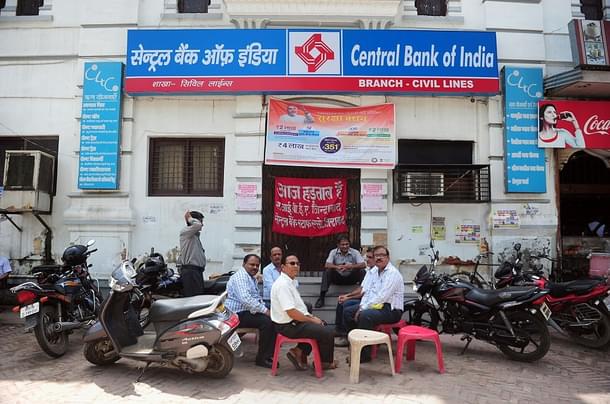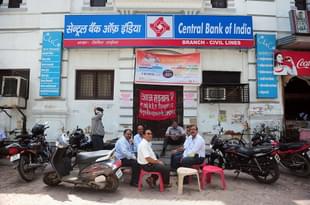Business
Let Denationalisation Of PSU Banks Begin – Not Stealthily, But Overtly
Krishna V Iyer
Jul 12, 2017, 02:58 PM | Updated 02:57 PM IST
Save & read from anywhere!
Bookmark stories for easy access on any device or the Swarajya app.


Former prime minister Indira Gandhi nationalised banks in two rounds in 1969 and 1980. Ostensible objectives for nationalisation was to achieve systematic and planned economic development of the country. Other objectives included social welfare, controlling private monopolies, expansion of banking, reducing regional imbalance, priority sector lending, developing banking habits etc.
Over the past few decades, nationalised banks rose to great heights – from about 7,000 odd branches to over 57,000 branches, over eight lakh employees, over 11,000 per cent jump in deposits and 9,000 per cent jump in lending (in the 40-50 years since nationalisation), with over 70 per cent market share in deposits/lending.
Over just a four-year period from 2012-13 to 2015-16 the government invested Rs 53,457 crore into the equity of banks and has plans to infuse an additional Rs 70,000 crores in the next three to four years. Its current equity value in most banks is largely red in colour with massive capital needs to keep the gasping banks on ventilator. Viral Acharya in a paper in June 2015 estimated the PSU (public sector undertaking) bank capitalisation requirement at between Rs 5.12 lakh crore and Rs 9.97 lakh crore based on then prevailing non-performing asset (NPA) loan problem (which has only ballooned higher in the two years since then to over Rs 10 lakh crore) and certain growth/Basel Capital requirement assumptions. This is clearly a huge drag on the financial capability of the government of India.
RBI’s Financial Stability Report of June 2017 highlights the fragility in the PSU banking space with its large and increasing non-performing loans issue and falling capital cover forcing RBI to put many banks under Preventive Corrective Action basically to stop them from further lending.
In terms of objectives from nationalisation, most are in tatters and many can be met without the state necessarily owning large chunks of the banking industry.
· Planned all-round economic development. No. Central planning and hubris surrounding it has been quietly buried
· Financial inclusion. No. Despite bank network growth, the citizens most in need for financial inclusion never got access to it
· Social welfare and justice. No
· Controlling private monopolies. Yes, done by introducing state monopolies with all its attendant ills – incompetence, inefficiency, crony capitalism, political interference etc.
· Expansion of banking – branch network increased by fiat but many branches are unviable and looked upon as punishment posting. Private banks and micro finance institutions (MFIs) managed much better reach via business correspondents network
· Reducing regional imbalance. No. East and north continue to trail west and south of India which was true at the time of nationalisation as well
· Priority sector lending – can be achieved without government having to own the sector
· Developing banking habits – country is developing banking habits, thanks to spread of technology and no thanks to the PSUs who famously fought to keep computers out to “protect jobs”
· Fraud prevention. No. Crony capitalism via banking sector is alive and kicking leading to massive NPA problem that threatens to destabilise PSU banks
· Competitive services. No. All banks hunkered down to the lowest acceptable service level
· Financial innovation. No. Most banks waited for either a Reserve Bank of India or State Bank of India to mandate a new product or service.
So what have we achieved over the years? Over the years we have managed to use the nationalised banking system to promote crony capitalism, to promote aggressive bank trade unions (thankfully defanged in the last decade), promote loan melas and assorted bad behaviour to promote political ends, meaningless expansion into unviable rural areas (which have hardly made a dent in the lives of locals), perpetuate the formal/informal economy divide by denying most of the informal economy (over 70 per cent by many estimates) access to the formal financial system.
As a counter example, private sector banks, non-banking financial companies (NBFCs), and other private financial entities continued to come up, offer services, prosper or die as per their merit. These entities showed that there is nothing exclusive to what the government does in the public sector banking system that cannot be provided as well or as badly as the PSUs by private entities. Also their success or failure have not led to any massive destabilisation of the system.
For an economy growing in nominal terms at around 10 per ent there is a continuing need for financial support which the dominant public sector has woefully failed to provide. Bank licences sparingly and reluctantly handed out by RBI have been gleefully lapped up by the private sector entrepreneurs, private capital of all types (IFC, sovereign funds, Private equity, VCs, public and private investors) and are stock market darlings across the range of financial services – mono-line NBFCs, private sector banks, MFIs, new age lenders etc. Financial services stock have been the toast of capital markets except if there is a government of India ownership/management tag attached to it.
The problems are well known and well documented. Umpteen committees have sat and prescribed common sense solutions to the current woes. Political compulsions have led the powers-that-be to brush it under the carpet, drip feed capital to the sickest of banks, urge mergers and other non-solutions to wish that a broader tide in the economy will lift all boats. If the capital infused in public sector banks over the last few years (amounting to over Rs 50,000 crores) was spent on acquiring minority say 5/10 per cent stake in banks like HDFC Bank, Yes Bank, Kotak Mahindra Bank or RBL by the government, it would have been in much better situation to meet some of its burgeoning financial needs to serve social purposes rather than see it vanish in another round of NPA recognition.
In this context, it is refreshing to hear former RBI Governor Y V Reddy suggest that trying to fix-and-sell banks may be a sub-optimal solution; it may be better to sell and let the buyers fix the mess. It is for the first time that someone of such standing has called out the obvious. In this day, where the privatisation/sale of Air India is being boldly championed, it is indeed refreshing that a call for a debate on selling off the public sector banks on an as-is-where-is basis is being made by such an illustrious person.
Nineteen July 1969 was the first round of nationalisation. With its forty-eighth anniversary falling in a few days time, now is as good a time as any to look at the whole bank nationalisation programme and declare it a failure and consequently a time to cut losses and move on. If we wish to sugar coat our words, lets agree that nationalisation has served its purposes and we can now exit from it and let the government come out of the industry except to regulate the service providers. Lets learn what history taught us in terms of human behaviour and the inability of lofty idealism to rein in base human instincts. Government ownership in most spheres (barring a rare ISRO or two) has been exploited by politicians, managers, workers and customers to their own needs and away from their stated objectives.
Except for a handful of banks like SBI and a few of the better managed banks, the rest should forthright be put on sale given the large private demand for bank licences. Fear of selling at the bottom should not be an excuse for delaying action and adding to our cost of bailing them. Government can retain minority stake to ride possible growth and anyway government is a partner via taxation of all businesses and their successes. The current philosophy of privatisation-by-stealth of the banking industry can be replaced with overt privatisation at a lower cost to the exchequer. The more we pussy-foot around the matter, the more disservice we do to the socially weak and to the future generations.
This article was originally published on Clean Slate India and republished here with permission.
Krishna V Iyer is an angel investor based in Pune. He has been an entrepreneur and a management consultant earlier. He tweets at @finkrishna.





